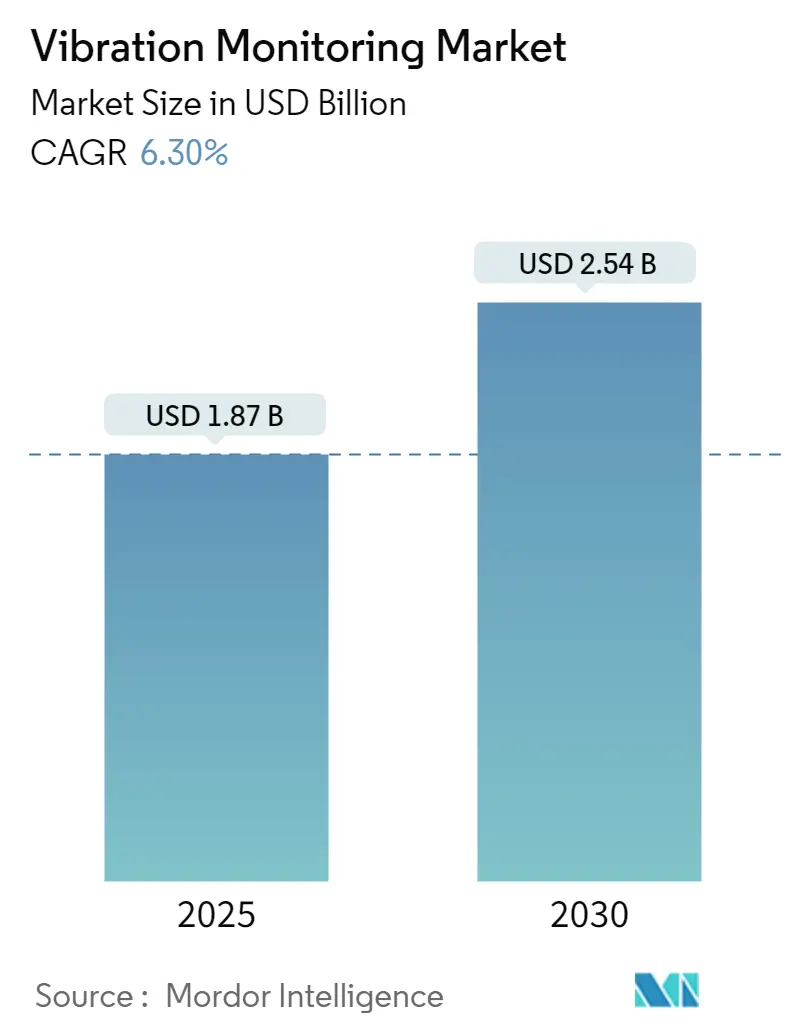
| Study Period | 2019 - 2030 |
| Market Size (2025) | USD 1.87 Billion |
| Market Size (2030) | USD 2.54 Billion |
| CAGR (2025 - 2030) | 6.30 % |
| Fastest Growing Market | Asia Pacific |
| Largest Market | North America |
| Market Concentration | Low |
Major Players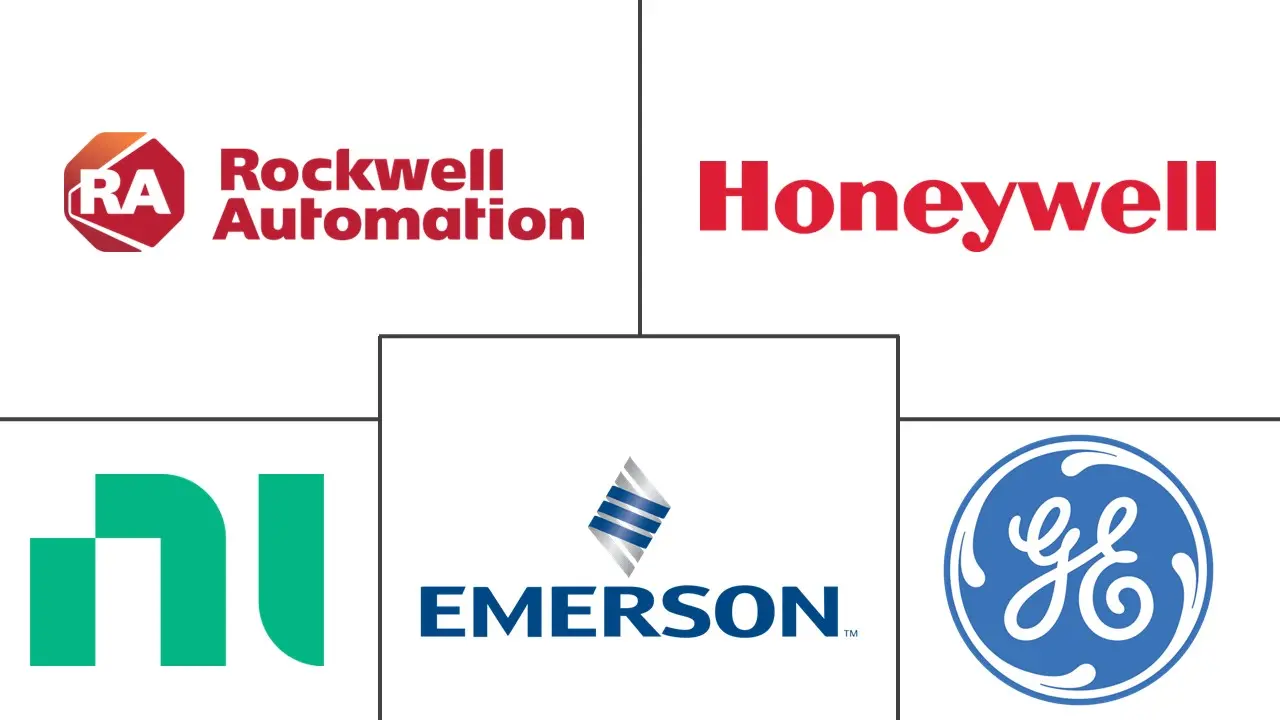
*Disclaimer: Major Players sorted in no particular order |
Vibration Monitoring Market Analysis
The Vibration Monitoring Market size is estimated at USD 1.87 billion in 2025, and is expected to reach USD 2.54 billion by 2030, at a CAGR of 6.3% during the forecast period (2025-2030).
The machine maintenance industry has experienced growth due to the optimization potential of maintenance processes, which have become more streamlined than production processes.
- Vibration monitoring is a critical aspect of predictive maintenance, and it is primarily used in rotating equipment such as steam and gas turbines, motors, pumps, compressors, paper machines, rolling mills, machine tools, and gearboxes. It is used to evaluate the operational and mechanical condition of equipment. Vibration analysis can detect developing problems before they become too severe and cause unscheduled downtime, which can be achieved by continuously monitoring machine vibrations or at predetermined intervals.
- Vibration condition monitoring equipment measures the vibration levels of rotating and reciprocating machinery. Sensors collect information on frequency and amplitude to measure the vibration patterns of machinery. Vibration monitoring is essential for tracking and analyzing changes in the condition of machinery parts, such as gears and bearings, and predicting equipment or part failure.
- The introduction of advanced technologies and services associated with the Internet of Things (IoT) is transforming most industrial applications. The opportunities for new entrants and traditional players to offer innovative solutions that change the business models are created by initiatives aimed at the automation of factories and implementing industrial smart maintenance, as well as efforts towards creating more innovative working environments. The vibration monitoring market is expected to grow strongly, thanks to the use of condition monitoring for preventive maintenance.
- Industries such as chemical, oil and gas, power and petrochemical, cement, and pharmaceuticals must abide by the stringent international policies that dictate process efficiency, ergonomics, and employee safety. Many toxic gasses and chemicals, such as polyaromatic hydrocarbons, ethylene, benzene, propylene, hydrogen sulfide, butadiene, butane, and sulfur, are generated as byproducts during the manufacturing processes. Therefore, vibration monitoring is gaining momentum as employee safety has gained paramount prominence.
- This significance has pushed various verticals to make extra efforts to protect their machinery. The main benefit of fault identification using condition monitoring is to allow personnel to take remedial action to avoid or reduce repair costs and increase machinery safety, thus improving human safety. The growth of the market is anticipated to be driven by various key factors, such as the rising acceptance of wireless systems in machine condition monitoring, the rising popularity of automated condition monitoring technologies and smart factory penetration, and the emergence of secure cloud computing platforms utilized in condition monitoring.
- The market's overall growth could be improved by the presence of technical expertise. Additionally, the market faces limitations due to ethical considerations imposed by governing bodies and a need for proficient technological resources for practical data analysis. Moreover, the market is expected to encounter challenges throughout the projected period, including the unavailability of expertise in remote areas and the increasing trend of integrating vibration monitoring systems with other maintenance practices.
- There has been a significant increase in the demand for remote operations due to the COVID-19 outbreak. A major decline in revenue growth for a number of industry communication companies worldwide took place during the 1st quarter of 2020. With the continued recovery of the economy and the growing need for remote operations, the market is becoming more and more active, leading to the adoption of highly automated systems that do not require any human oversight.
Vibration Monitoring Market Trends
Oil and Gas to Hold Significant Market Share
- Oil and gas operations operate in extreme operating environments, such as offshore drills and petrochemical refineries. There are severe financial and environmental consequences for any mechanical defeat. Thus, the detection and prevention of unpredictable oil and gas machinery and component issues are mandated in many parts of the world. The flammable oil price environment expands the adoption of predictive maintenance technologies, as these help organizations cut operational expenses by optimizing maintenance scheduling and driving productivity.
- The oil and gas industry is at the forefront of adopting innovative technologies to optimize operations, enhance efficiency, and ensure safety in the rapidly evolving landscape of the (IoT). This industry is subject to strict regulatory standards to ensure operational safety and environmental protection. Vibration monitoring is a proactive measure that helps companies comply with these regulations. By leveraging vibration sensors and adopting a proactive approach to maintenance, the oil and gas industry can optimize asset performance, enhance safety, and achieve substantial cost savings.
- The oil and gas industry is anticipated to dominate the expanding Market. The energy and power industry includes several segments, such as coal, nuclear power, minerals, and clean fuels. The raised spending from the government and the private sector on alternative energy and power sources in developed and developing nations is resulting in the installation of more additional energy and power plants, thus fueling the need for vibration monitoring procedures. For instance, in March 2022, the Board of Oil India approved an investment of INR 6,555 crore (USD 839.49 million) for the Numaligarh petrochemical project. Such projects will enhance the application opportunities for vibration monitoring systems.
- In addition, in January 2022, Indian Oil Corp. Ltd. (IOCL) announced plans to extend its city gas distribution (CGD) industry, looking to invest INR 7,000 crore (USD 918.6 million). Further, in May 2022, ONGC announced plans to invest USD 4 billion from FY22-25 to increase its exploration efforts in India. Such initiatives may further propel the studied market growth.
- Vibration monitoring solutions are critical in the oil and gas industry as they ensure that the production machinery is operational and downtime is minimized, lowering operating costs and increasing productivity and monetary gains. A vibration monitoring system aids in the reduction of unplanned outages and the optimization of machine performance, thus reducing maintenance and repair costs.
- The demand for downhole vibration monitoring and control systems is expected to increase significantly in the coming years to increase profitability and reduce downtime in upstream operations. According to METI (Japan), in 2022, the import volume of crude oil from the United Arab Emirates to Japan reached more than 60.3 million kiloliters. The majority of nearly 30 million kiloliters comprised oil from the Murban oil field, followed by oil from Das Island at around 17.7 million. The applications of the downhole vibration monitoring control system have been expected to grow further with upcoming exploration and drilling projects in countries such as the United States, Saudi Arabia, and the United Arab Emirates.
- In addition, according to OPEC, the international Crude oil consumption reached 99.57 million barrels a day in 2022, which included biofuels is projected to grow to 101.89 million barrels per day in 2023. Furthermore, the adoption of vibration monitoring is high in the oil and gas sectors. It is used for predictive analysis, which helps manufacturers increase their productivity and maximize operational efficiency. Condition monitoring is required for vibration analysis on vital machines to manage and prevent unexpected shutdowns due to unforeseen machinery failure within the oil and gas sector.
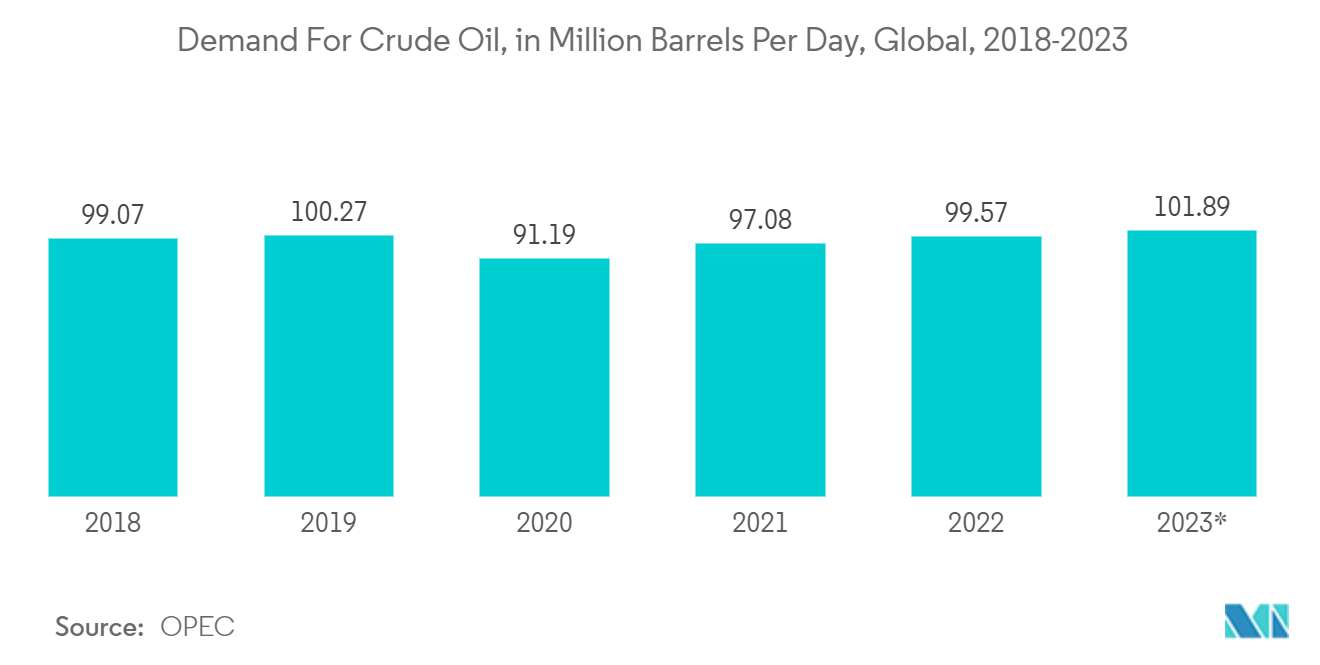
Asia-Pacific to Witness Significant Market Growth
- China is a prominent global manufacturing center with the largest population globally, and it is increasing investments in the power and infrastructure sectors. The Chinese government has previously declared investments worth USD 78 billion to construct 110 nuclear power plants, which are scheduled to become operational by 2030. These advancements are anticipated to expand the potential for adopting contemporary technologies, such as vibration monitoring solutions, to facilitate condition-based monitoring.
- Increasing adoption and awareness of predictive maintenance and vibration monitoring technologies in the power, oil and gas, cement, chemical and petrochemical, and automotive firms, coupled with government ambitions, such as 'Made in China 2025', may design sustained demand for vibration monitoring in Asia-Pacific during the forecast period.
- Despite the falling hydrocarbon energy prices, there is a continued focus on oil and gas exploration activities to achieve energy self-sufficiency by NOCs, such as CNPC in China. These activities are anticipated to create a robust demand for vibration-monitoring solutions to monitor and facilitate the maintenance of oil and gas equipment and infrastructures. China has the most significant shale oil and gas reserve worldwide and focuses on tapping the same through joint ventures with oil and gas companies.
- Vibration monitoring is an integral part of a predictive maintenance program. Regularly inspecting and monitoring the condition of oil and gas pumps can help identify and address potential problems before they cause failure, thus saving time and money by avoiding unplanned outages and unnecessary repairs. Increasing investment in various applications in the studied market may further propel growth. According to IBEF, India's LNG import was predicted at 2,266 million metric standard cubic meters (MMSCM) in January 2023. According to IEA, natural gas consumption in India is expected to grow by 25 BCM, recording an average annual boost of 9 percent until 2024.
- India boasts one of the largest automotive markets globally. As per SIAM, approximately 21.2 million vehicles were sold in India during FY 2023. In June 2022, domestic passenger vehicle wholesales witnessed a 2.2 percent surge, reaching 3.27 lakh units, while two-wheeler sales experienced a 1.7 percentage increase, totaling 13.30 lakh units, as reported by the Society of Indian Automobile Manufacturers (SIAM). Additionally, the government aims to achieve a 40 percent electric vehicle sales penetration for buses, 30 percentage for private cars, and 70 percent for commercial vehicles by 2030. Therefore, with the rising automotive industry and growing sales capabilities, the need for vibration monitoring in the sector is expected to increase.
- Preventive maintenance has emerged as a crucial requirement in the Food and Beverage Industry. Furthermore, vibration monitoring can effectively avert downtime, identify fundamental machine health, and minimize energy expenses by anticipating impending equipment malfunctions and rectifying them proactively. The escalating investments in the food sector are expected to generate abundant prospects for the market and vendors to cater to the demand.
- For instance, According to the (MFDS), the food industry's total production value in South Korea accounted for approximately 3.15 percent of the country's GDP in 2022, a slight increase from 2.91 percent in the previous year. Additionally, South Korea aims to enhance the vitality of five significant sectors within the local food industry as part of its 2030 objective to double the sector's value. Similarly, according to the Korea Food and Drug Administration, the Korean food industry has experienced significant growth in recent years, with an annual increase of approximately 8.1 percent. These capabilities will contribute to the market's demand.
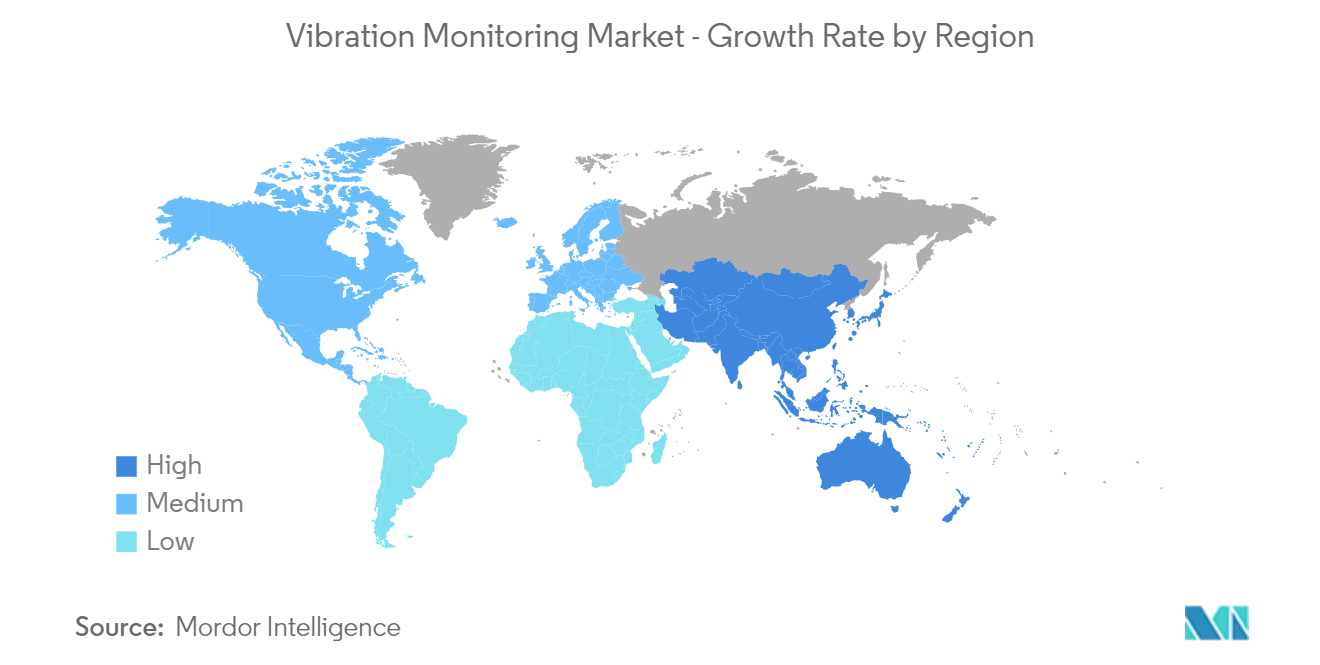
Vibration Monitoring Industry Overview
The vibration monitoring market is significantly competitive. Some significant players in the Market are Rockwell Automation Inc., National Instruments Corporation, General Electric Corporation, Emerson Electric Company, Honeywell International Inc., and Bruel & Kjaer Sound & Vibration Measurement. The companies are increasing their market share by forming multiple partnerships and introducing new products to earn a competitive edge.
In August 2022, Rockwell Automation Inc., a company providing innovative solutions in the area of decarbonization focused on battery production, vehicles, and energy storage technologies, teamed up with Bravo Motor Company, a California firm that offers an array of services to businesses. Automotive manufacturers rely on noise vibration monitoring and harshness testing to optimize vehicle performance and keep a standard of comfort across their automobile catalog.
In February 2022, Pepperl+Fuchs started offering a range of vibration sensors to perform reliable measures of vibration velocity and acceleration in lower or high-frequency fields. Pepperl+Fuchs vibration sensors are licensed to SIL 2, and they have a large measurement capacity of up to 128 mm per minute, as well as an automated state detecting for ball bearings compared with competing products. The sensors impress with a maintenance-free operation and long service life due to their robust housing encased in electronics.
Vibration Monitoring Market Leaders
-
Rockwell Automation, Inc.
-
National Instruments Corporation
-
General Electric Corporation
-
Emerson Electric Company
-
Honeywell International Inc.
- *Disclaimer: Major Players sorted in no particular order
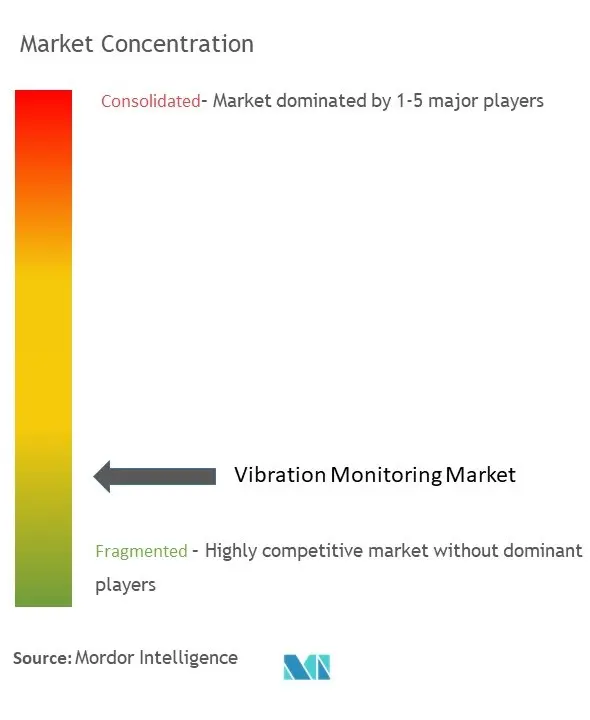
Vibration Monitoring Market News
- May 2022: STMicroelectronics released ASM330LHHX, the first inertial measurement unit (IMU), taking a step closer to high levels of automation with its machine-learning (ML) core. The ML core enabled fast real-time response and sophisticated functions with low system power demand. The ASM330LHHX had two operating modes. One was the low-power mode for running always-on applications like telematics, anti-theft systems, motion-activated functions, and vibration monitoring and compensation.
- April 2022: Banner Engineering introduced a new IIoT product line, Snap Signal. It captured data from nearly any industrial machine’s device and converted it to a standard protocol, thereby enabling an upgrade to Industry 4.0 and higher productivity. Snap Signal's products were used to build a brand-agnostic IIoT platform composed of modular hardware and software. Snap Signal can unlock facilities’ potential in vibration monitoring system applications.
Vibration Monitoring Industry Segmentation
Vibration monitoring is a fundamental concept in industrial machinery dynamic control. With the advancement of technology, current vibration monitoring systems that integrate complexity and performance can provide workers with comprehensive, near-real-time diagnostic information on the machines' actual dynamic state and implementation. Structural vibration monitoring is another market component that is extremely important as a target for business generation in the market for vendors.
The vibration monitoring market is segmented by type (hardware (displacement, velocity, and acceleration), software, and services), end-user industry (automotive, oil and gas, energy and power, mining, food and beverage, and chemicals), and geography (North America, Europe, Latin America, Asia-Pacific, and the Middle East and Africa).
The market sizes and predictions are provided in terms of value in USD for all the above segments.
| By Type | Hardware | Accelerometer |
| Velocity | ||
| Displacement | ||
| Other Hardware | ||
| Software | ||
| Services | ||
| By End-user Industry | Automotive | |
| Oil and Gas | ||
| Energy and Power | ||
| Mining | ||
| Food and Beverage | ||
| Chemicals | ||
| Other End-user Industries | ||
| By Geography | North America | |
| Europe | ||
| Asia Pacific | ||
| Latin America | ||
| Middle-East and Africa |
Vibration Monitoring Market Research Faqs
How big is the Vibration Monitoring Market?
The Vibration Monitoring Market size is expected to reach USD 1.87 billion in 2025 and grow at a CAGR of 6.30% to reach USD 2.54 billion by 2030.
What is the current Vibration Monitoring Market size?
In 2025, the Vibration Monitoring Market size is expected to reach USD 1.87 billion.
Who are the key players in Vibration Monitoring Market?
Rockwell Automation, Inc., National Instruments Corporation, General Electric Corporation, Emerson Electric Company and Honeywell International Inc. are the major companies operating in the Vibration Monitoring Market.
Which is the fastest growing region in Vibration Monitoring Market?
Asia Pacific is estimated to grow at the highest CAGR over the forecast period (2025-2030).
Which region has the biggest share in Vibration Monitoring Market?
In 2025, the North America accounts for the largest market share in Vibration Monitoring Market.
What years does this Vibration Monitoring Market cover, and what was the market size in 2024?
In 2024, the Vibration Monitoring Market size was estimated at USD 1.75 billion. The report covers the Vibration Monitoring Market historical market size for years: 2019, 2020, 2021, 2022, 2023 and 2024. The report also forecasts the Vibration Monitoring Market size for years: 2025, 2026, 2027, 2028, 2029 and 2030.
Our Best Selling Reports
Vibration Monitoring Industry Report
Statistics for the 2025 Vibration Monitoring market share, size and revenue growth rate, created by Mordor Intelligence™ Industry Reports. Vibration Monitoring analysis includes a market forecast outlook for 2025 to 2030 and historical overview. Get a sample of this industry analysis as a free report PDF download.




